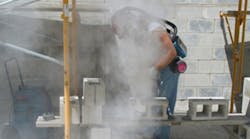Several industry groups have issued statements regarding the Occupational Safety and Health Administration’s proposed Crystalline Silica Rulemaking. Released by OSHA on Aug. 23 during a news conference, the proposed rule seeks to lower worker exposure to crystalline silica, a natural occurring component of soil, sand, granite, and other minerals. Many common construction operations in dozens of specialty trade activities involve silica, including those that cut, grind, crush, or drill materials that contain silica, such as concrete, masonry, tile or rock.
The Construction Industry Safety Coalition, which represents 25 construction trade associations issued the following statement:
“After an exhaustive analysis that involved hundreds of construction safety professionals, builders, construction managers and specialty trade contractors representing virtually every facet on the industry, it is our conclusion that the administration’s proposed new silica rule is significantly flawed and will do little to improve workplace health or safety. Specifically, the proposed rule sets a silica exposure standard that cannot be accurately measured or protected against with existing equipment and includes a series of data errors that undermine many of the rule’s basic assumptions."
Associated Builders and Contractors, as part of the Construction Industry Safety Coalition, requested OSHA withdraw the proposed rule: “OSHA’s crystalline silica proposal is potentially the most egregious regulatory initiative that OSHA has proposed for the construction industry,” said ABC Vice President of Government Affairs Geoff Burr. “In addition to failing to demonstrate a need for the rule, OSHA has severely underestimated the compliance impact. The proposal likely will impact 1.5 million more construction workers than OSHA estimated and will cost at least four times as much to implement.”
The American Subcontractors Association said it does not believe that the proposed rule meets the required standards of technological and economic feasibility. "In more plain language, ASA believes that the proposed rule is simply unworkable and its requirements unattainable for most employers in today’s construction environment.”
ASA recommended that OSHA undertake a new rulemaking process that “assures that those who work in the construction industry are protected from unnecessary exposure to crystalline silica, is underpinned with good science, and for which implementation is both technologically and economically feasible for construction employers.”
ASA pointed out several flaws in the proposed rule. For example, OSHA relied on a 10-year-old Small Business Regulatory Enforcement Fairness Act panel review that used economic data that “does not reflect today’s construction industry — an industry that has not recovered from a nearly unprecedented boom and bust cycle.”
ASA also noted internal inconsistencies in the proposed rule: “For example, OSHA states both that construction employees do not perform tasks for entire shifts and that, in response to the proposed rule, ‘construction work involving silica exposure will tend to become a full-time job for some construction workers.’ That is, even OSHA admits that implementation of its proposed rule is likely to lead to workers being exposed to silica for longer periods of time. If so, ASA finds OSHA’s conclusion alarming and in contravention of OSHA’s very mission — to assure safe and healthful working conditions for working men and women.”
ASA also expressed its concern that OSHA does not take into consideration the dynamic environment and the unique multiemployer nature of construction. ASA wrote that “in order to comply with OSHA’s proposed rule, a construction employer with employees who perform tasks that can potentially expose them to crystalline silica would seem to need access to a non-silica-based crystal ball to predict changing variables as diverse as the direction of the wind and the practices of another contractor on the job site, or be prepared to deploy controls and equipment on practically every site, significantly increasing its costs.”
ASA also pointed out problems with the proposed rule’s exposure assessment requirements, requirement for regulated areas, methods of compliance, medical surveillance requirements and recordkeeping requirements.
In addition, ASA endorsed the extensive comments submitted by the Construction Industry Safety Coalition of which it is a member. In conjunction with the Coalition, ASA called on OSHA to engage “in a meaningful dialogue on a workable approach to continuing the measurable trend in the reduction of silicosis-related diseases.”



